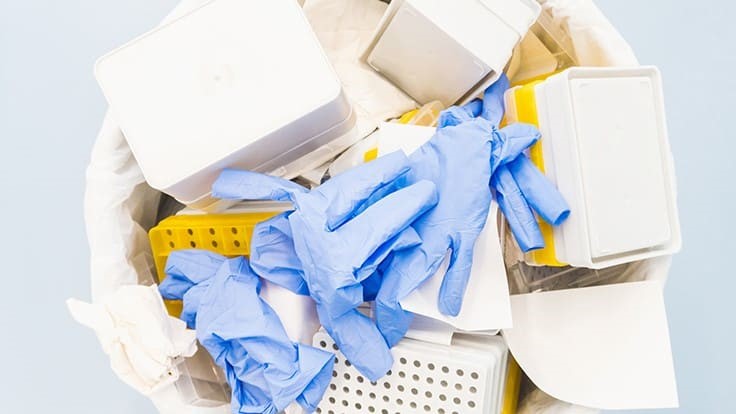Medical waste is any kind of waste that contains infectious material or material that could potentially cause infection. This includes waste generated by healthcare facilities such as physician’s offices, hospitals, dental practices, laboratories, medical research facilities and veterinary clinics. Medical waste can come in many forms, from sharps (such as needles and syringes) to human tissue and body fluids. It can also include pharmaceuticals and chemicals. If not properly disposed of, medical waste can pose a serious health risk to both the public and the environment. This is why it’s important for healthcare facilities to have proper medical waste disposal procedures in place. With the proper procedures in place, medical waste can be safely disposed of without posing a risk to human health or the environment.

Types of Medical Waste
Infectious or Biohazardous Waste is waste that’s contaminated with things that could infect people. It includes materials with blood or other bodily fluids in or on them, cultures and stocks of infectious substances from lab work, and waste from people with infections, like swabs, bandages, and disposable medical supplies. Labs or sites that do COVID-19 tests, for example, treat all medical waste as biohazardous. Infectious waste can pose a serious threat to public health if it’s not disposed of properly. That’s why it’s important to follow proper procedures for handling and disposing of infectious waste. For example, you should use gloves and other personal protective equipment when handling infectious waste, and you should disinfect surfaces that come into contact with the waste. You should also segregate infectious waste from other types of waste, and you should label it clearly as “infectious” or “biohazardous.”
Sharps Waste includes items such as syringes, needles, and disposable scalpels and blades. These items can pose a serious infection risk if they come into contact with skin. As a result, it is important to never toss sharps into bags, trash cans, recycling bins, or toilets. Instead, they should be disposed of in special sharps containers that are designed to prevent accidents.
Pathological Waste refers to any waste material that comes from human or animal tissues, organs or fluids. This can include everything from body parts to contaminated animal carcasses. Pathological waste can be extremely dangerous if not properly disposed of, as it can harbor dangerous pathogens that can cause serious illness or even death. Proper disposal of pathological waste is essential to protect public health and safety. There are a number of different methods that can be used to dispose of this type of waste, including incineration, autoclaving and chemical disinfection. While each method has its own advantages and disadvantages, all of them are effective at neutralizing the dangers posed by pathological waste.
Chemical Waste is any material that is no longer wanted or needed. This can include solvents and other substances used for laboratory preparations, as well as disinfectants and other cleaners. Chemical waste can be both hazardous and non-hazardous. Hazardous waste is any material that is flammable, corrosive, or poisonous. Non-hazardous waste is any material that is not flammable, corrosive, or poisonous. Chemical waste must be disposed of properly to avoid contamination of the environment. There are several ways to dispose of chemical waste, including recycling, incineration, and landfilling. Recycling is the process of breaking down a substance into its component parts so that it can be used again. Incineration is the process of burning a substance to produce energy. Landfilling is the process of burying a substance in the ground. Chemical waste must be disposed of properly to protect the environment from contamination.

Pharmaceutical Waste refers to any expired, unused, or contaminated drugs or vaccines. This type of waste can be a significant public health hazard if it is not disposed of properly. Pharmaceuticals can enter the environment through a variety of channels, including sewage systems, landfills, and incinerators. Once in the environment, they can contaminate soil and water resources and potentially harm human health. Improper disposal of pharmaceuticals also represents a financial burden for healthcare facilities and the taxpayers who support them. Luckily, there are a variety of ways to effectively manage pharmaceutical waste. In many cases, healthcare facilities can partner with specialized companies that will safely dispose of the waste. Alternatively, some facilities may choose to incinerate or autoclave their waste to ensure that it is destroyed. Whatever method is used, it is important to ensure that pharmaceutical waste is properly managed to protect public health and the environment.
Cytotoxic Drugs are powerful medications that can kill cancer cells. However, they can also damage healthy cells, and their waste products can be dangerous to human health. Cytotoxic waste typically contains heavy metals, organic solvents, and other hazardous materials. Exposure to these substances can cause skin irritation, respiratory problems, and even cancer. As a result, it is important to take precautions when handling or disposing of cytotoxic waste. Many hospitals have special units for storing and disposing of this type of waste, and workers must take care to avoid coming into contact with it. With proper precautions, however, the risks posed by cytotoxic waste can be minimized.
Radioactive Waste is waste that contains radioisotopes (isotopes of elements that decay radioactively). The radioactivity can come from a nuclear medicine imaging test, radiation therapy, or PET scan. The risk of radiation exposure from radioactive waste depends on the type and amount of radioactive isotope in the waste, how long the waste has been stored, and the container that the waste is stored in. Radioactive waste can be a health hazard if it is not properly managed. Improper disposal of radioactive waste can contaminate soil and water, which can lead to exposure of people and animals. Proper management of radioactive waste includes storage, transportation, and disposal in a designated facility. Storage facilities for radioactive waste are designed to minimize the risks of release into the environment. Transportation of radioactive waste is regulated to minimize the risk of exposure and contamination. Disposal facilities for radioactive waste are designed to isolate the radioactivity from people and the environment. Radioactive waste must be disposed of in a licensed facility that is authorized by the Nuclear Regulatory Commission.

Nonhazardous Medical Waste is most of the trash that you see in a hospital or doctor’s office. This type of waste generally doesn’t pose any biological, chemical, radioactive, or physical risk to your health. It can include paper or plastic trash, gloves and gowns, packaging, wrappers, and containers. Dressing that doesn’t have blood or potentially infectious materials on them is also considered nonhazardous medical waste. While this type of waste may not be dangerous to your health, it’s important to dispose of it properly to prevent the spread of infection.
If you have any questions about how to handle infectious or biohazardous waste, you should contact your local health department or the hazardous waste management program in your state.

